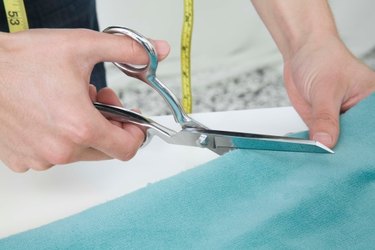Things You'll Need
Measuring tape
Seam ripper
Tailor's chalk
Scissors
Steam iron
Pins
Needle and thread

Lined drapes provide light control and privacy while giving you a chance to add a decorative element to your rooms. However, they can be expensive due to construction techniques and the extra fabric involved. Whether you're moving and want to take your lined drapes with you or were given lined drapes that are too long, shortening drapes can be an easy way to furnish your new home. Shortening drapes is an economical way to save money and get just the look you want.
Step 1
Hang the lined drapes from the hardware in the window where you intend them to hang. Measure the drapes and mark the desired new hem. Take the drapes down.
Video of the Day
Step 2
Remove the existing hems from the drapery and the lining material with a seam ripper or sharp scissors, being careful to not cut the decorative drapery fabric. Remove the side seam holding the lining and drapery fabric together, removing enough of the seam to allow room to fold up the new hems. Press any folds created by removing the hem with a steam iron set to the appropriate setting for the drapery fabric.
Step 3
Lay the drapery on a flat surface. Measure and mark with tailor's chalk the new hem across the width of the decorative fabric of the panel based on the measurement taken in Step 1.
Step 4
Cut the excess fabric from the panel and lining, leaving enough to create a double-fold hem in the drapery panel and a 3/4-inch double-fold hem in the lining fabric. Drapes that reach the sill typically have a 6 inch hem allowance, creating a 3-inch double-fold hem; drapes that reach the floor have an 8 inch hem allowance, creating a 4-inch hem. Linings typically have an 1 1/2-inch hem allowance.
Step 5
Sew a double-fold hem in the decorative drapery panel and the lining fabric by folding up the full hem allowance and pressing the fold in place. Unfold the hem, refold the raw edge of the fabric up to the fold, press the new fold and then fold again along the original fold line. Press the hems in place.
Step 6
Stitch the lining fabric to the side hem of the drapery panel, following the method the lining was originally attached, and press. Hang the draperies.
Tip
Make note of how the lining fabric is attached at the sides. You'll be reattaching the lining in the same manner when you've completed the hem.
Double-folded hems conceal the raw edge of the drapery fabric and provide a substantial hem, which helps drapes hang gracefully.
If the drapes did not have double-folded hems to begin with, you may not need to cut any fabric to create shorter drapes by making double-folded hems.
Video of the Day